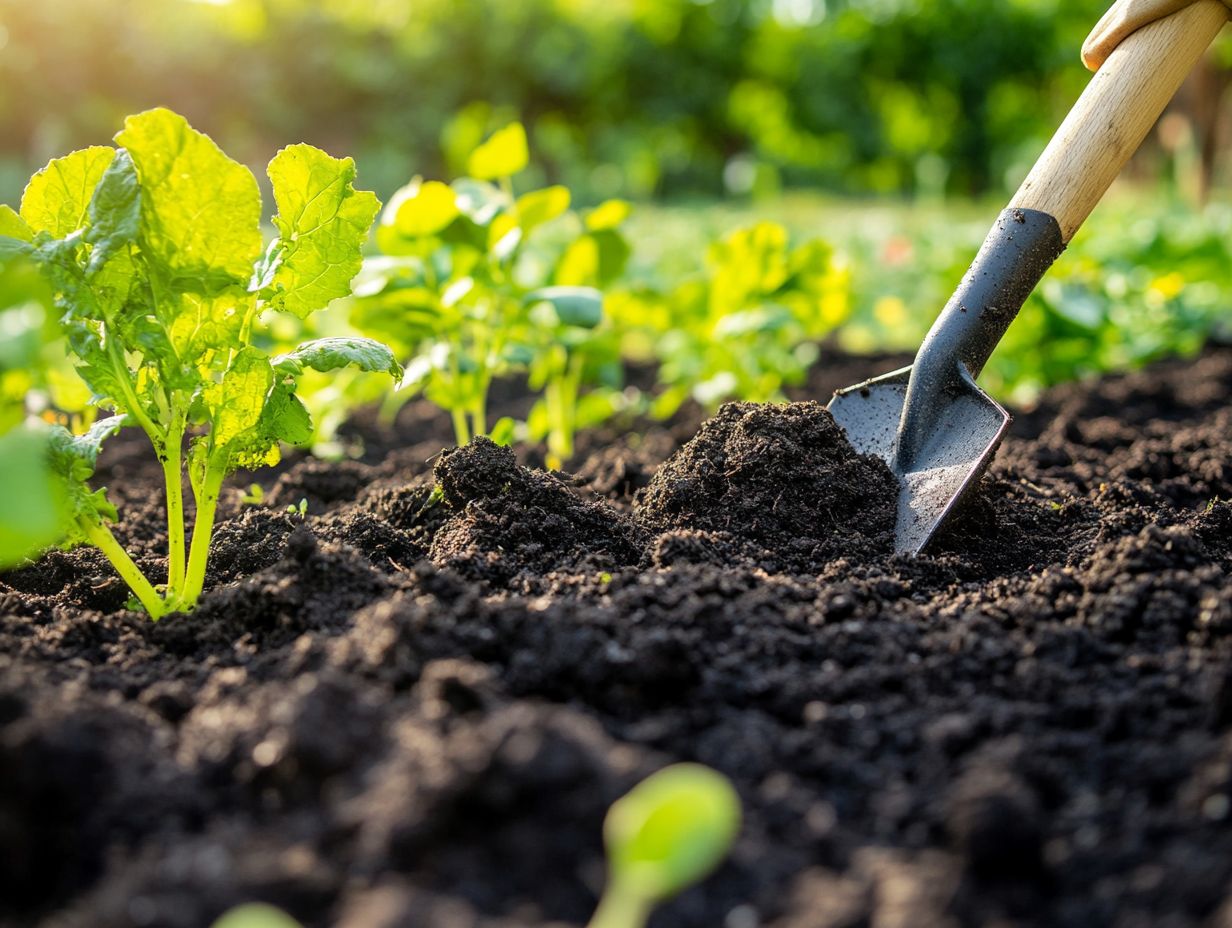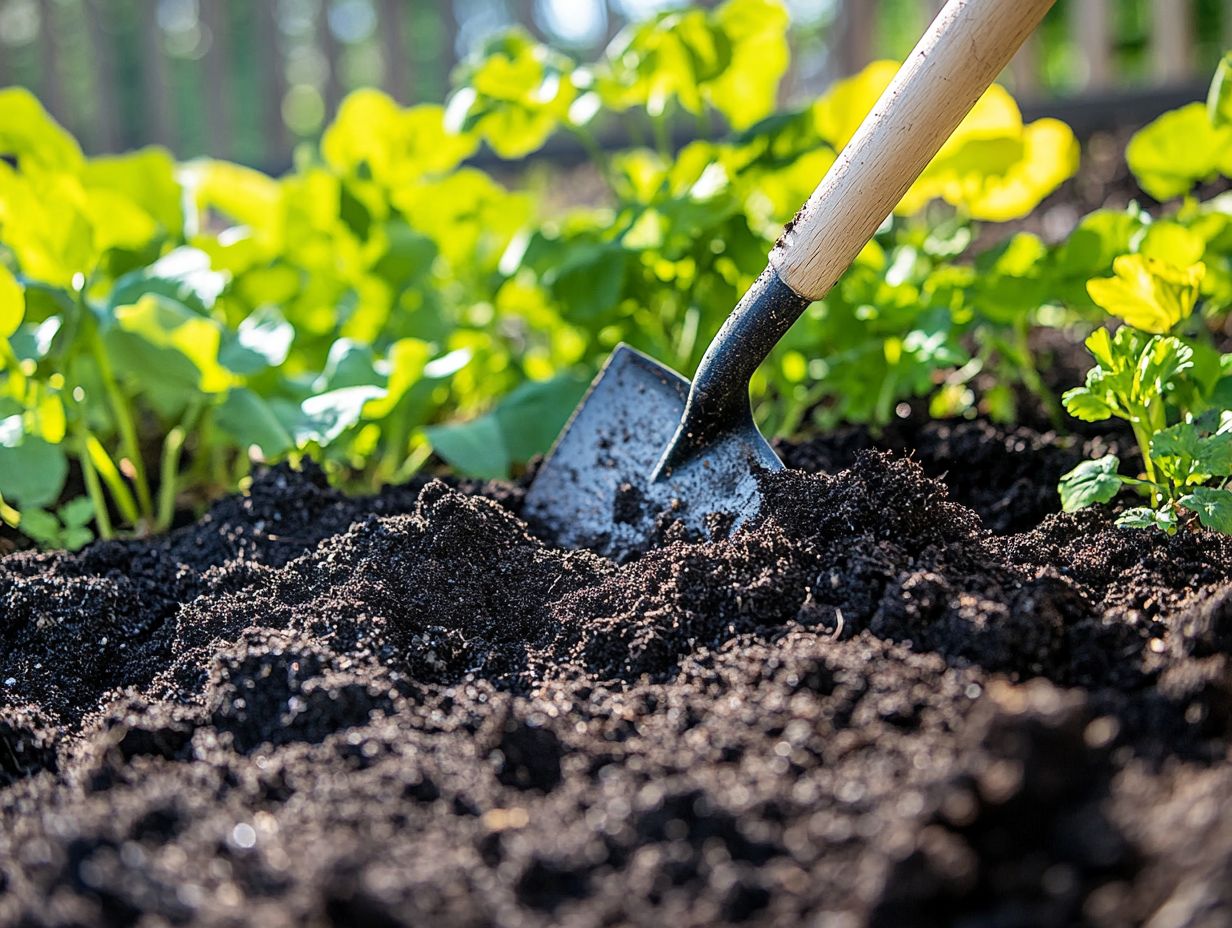How to Restore Nutrient-Depleted Soil
Healthy soil serves as the cornerstone for flourishing plants and resilient ecosystems. Recognizing the significance of nutrient-rich soil is crucial for anyone who is passionate about gardening or agriculture.
This article explores why soil quality is paramount, identifies common causes of nutrient depletion, and presents effective strategies for revitalizing soil health.
From organic fertilizers and composting techniques to best practices for prevention, you ll discover practical insights designed to help you cultivate vibrant, nutrient-dense soil. Are you ready to transform your garden into a thriving oasis?
Contents
Key Takeaways:

- Nutrient-rich soil is essential for healthy plant growth and overall ecosystem health.
- Identifying and addressing soil imbalances is crucial in restoring nutrient-depleted soil.
- Using organic fertilizers, composting, cover crops, and crop rotation can effectively restore nutrients to soil.
The Importance of Nutrient-Rich Soil
Nutrient-rich soil is essential for sustainable agriculture, acting as the cornerstone for robust plant growth and important functions for the ecosystem. When organic matter flourishes in the soil, it elevates quality and enhances water retention, ultimately boosting crop yields.
This fertile ground nurtures diverse plant communities and encourages beneficial microbial activity, which refers to the work done by tiny organisms in the soil that help plants grow. By adopting responsible agricultural practices that promote soil regeneration, you can effectively combat soil degradation and nutrient depletion.
Safeguarding long-term soil health ensures agricultural productivity for the future. Act now to prevent further soil loss!
Why Soil Quality Matters for Plant Growth
Soil quality is a critical factor that directly influences your plant growth. It determines the availability of essential nutrients and guides moisture management.
When the soil is well-structured, it supports healthy root development and allows for proper aeration. An optimal level of organic matter enhances microbial activity, enriching the nutrient pool even further.
Nutrient availability including key elements like nitrogen, phosphorus, and potassium is vital for robust plant processes such as photosynthesis and respiration.
Together, these components create an environment that fosters ideal plant development, ultimately leading to improved agricultural productivity. By prioritizing high soil quality, you can ensure healthy crops while also embracing sustainable farming practices that nurture the land for future generations.
Common Causes of Nutrient-Depleted Soil
Nutrient-depleted soil presents a formidable challenge in modern agriculture. This issue often stems from prevalent factors such as soil erosion, over-cultivation, and agricultural runoff.
Engaging in these practices can lead to a concerning depletion of nutrients, compromising soil health and diminishing agricultural productivity over time.
Identifying and Addressing Soil Imbalances

Identifying and addressing soil imbalances is essential for maintaining soil health and elevating agricultural productivity. When imbalances occur, they can lead to nutrient deficiencies that adversely impact your crop yields.
To effectively tackle these issues, begin by utilizing soil testing and analysis to pinpoint specific nutrient deficiencies. Regular assessments enable you to make informed decisions regarding nutrient applications and necessary modifications.
Next, consider implementing strategies such as incorporating organic matter, like compost or cover crops, to enhance both soil structure and fertility. Adopting crop rotation practices can also help naturally replenish essential nutrients.
By prioritizing these nutrient management practices, you can not only address existing imbalances but also promote long-term sustainability and resilience within your farming systems.
Methods for Restoring Nutrients to Soil
Restoring nutrients to the soil is essential for sustainable agriculture! You can achieve this through various effective methods.
Consider incorporating:
- organic fertilizers,
- composting techniques,
- cover crops, and
- crop rotation.
Each of these approaches enhances soil health and fosters a more resilient agricultural ecosystem.
Organic Fertilizers and Composting
Organic fertilizers and composting are powerful allies in your quest to enrich soil nutrients and boost the activity of tiny living things in the soil, both vital for maintaining robust soil health.
These practices enhance the availability of essential minerals while promoting better soil composition and increasing nutrient retention. When you transform organic materials like kitchen scraps and yard waste into compost, you create a slow-release source of nutrients that plants can draw from over time. This gradual nutrient release minimizes the risk of leaching and ensures that your plants receive a consistent supply of what they need to flourish.
Applying organic fertilizers amplifies microbial diversity in the soil, a critical component in breaking down organic matter and enhancing overall soil fertility. By embracing these eco-friendly techniques, you cultivate thriving ecosystems that support healthy plant growth and contribute to sustainable agricultural practices.
Cover Crops and Crop Rotation
Utilizing cover crops and implementing crop rotation are exceptional agricultural practices that significantly enhance nutrient cycling and improve soil structure! These techniques foster biodiversity and play a crucial role in bolstering soil health.
Deep-rooted plants prevent soil erosion, protecting your land from the adverse effects of wind and water runoff. Cover cropping creates a habitat for beneficial organisms, further enhancing nutrient availability. Meanwhile, crop rotation introduces a variety of nutrients to the soil, minimizing the risk of depletion and disrupting the cycles of pests and diseases.
Together, these methods forge a resilient agricultural system that champions both sustainability and productivity.
Testing and Monitoring Soil Health

Start testing and monitoring your soil health today! This practice is crucial for understanding nutrient levels and ensuring optimal soil quality, both of which directly impact agricultural productivity.
By prioritizing these assessments, you gain valuable insights that help you make informed decisions and enhance the vitality of your crops.
How to Determine Nutrient Levels in Soil
Determining nutrient levels in your soil can be achieved through comprehensive soil testing, offering invaluable insights for effective nutrient management and enhancing soil health.
This process encompasses advanced and accessible methods tailored to your specific needs. Laboratory analyses deliver precise results, using sophisticated techniques to identify concentrations of essential nutrients, the acidity or alkalinity of the soil, and organic matter content. On the other hand, DIY testing kits provide a hands-on approach, allowing you to quickly assess nutrient levels in your soil without leaving your home.
These assessments are essential for refining your fertilization strategies and making informed decisions about crop selection. Start using these methods today to cultivate rich, thriving ecosystems and optimize agricultural productivity!
Preventing Nutrient Depletion in the Future
To prevent future nutrient depletion, embrace the best practices in sustainable agriculture!
Prioritizing soil health and implementing effective nutrient management strategies will be key to ensuring a thriving ecosystem for generations to come.
Best Practices for Maintaining Healthy Soil
Implementing best practices for maintaining healthy soil is essential for sustainable agriculture. It ensures soil conservation and enhances biodiversity.
To achieve these important goals, you can employ a variety of techniques tailored to protect and enrich the health of your soil. Discover the incredible benefits of crop rotation, which not only disrupts pest cycles but also boosts nutrient availability.
Cover cropping is another effective strategy. It can prevent erosion and significantly improve organic matter.
Incorporating compost and organic fertilizers is crucial for replenishing essential nutrients. Practices like reduced tillage support the natural ecosystems within your soil, fostering a diverse microbial community and enhancing overall soil structure.
By combining these methods, you contribute to a more resilient agricultural system that benefits both the environment and your productivity. Act now to restore your soil health before it s too late!
Frequently Asked Questions

What is nutrient-depleted soil?
Nutrient-depleted soil is soil that lacks essential nutrients for plant growth, such as nitrogen, phosphorus, and potassium.
How does soil become nutrient-depleted?
Soil can become nutrient-depleted due to factors such as intensive farming practices, erosion, and leaching from excessive rain or irrigation.
Why is it important to restore nutrient-depleted soil?
Restoring nutrient-depleted soil is important because it allows plants to grow and thrive. This is essential for sustaining our food supply and maintaining a healthy ecosystem.
What are some signs of nutrient-depleted soil?
- Stunted or yellowing plants
- Poor water retention
- Increased weed growth
What are some methods for restoring nutrient-depleted soil?
- Adding organic matter
- Using cover crops
- Rotating crops to promote natural nutrient replenishment
How can I prevent soil from becoming nutrient-depleted?
To prevent soil from becoming nutrient-depleted, practice sustainable farming methods such as crop rotation, composting, and using natural fertilizers instead of synthetic ones.






